Dual Magazine No. 6
Kunio Okawara Design Room
The designs in this issue are all variations of the ones that appeared on TV. This is the direction of both works. For the A.T., I had firm requests from Directors Takahashi and Takizawa, and Mr. Inoue, who is in charge of concepts. I tried not to make any major changes.
As for the camera on the A.T.’s face, in any work there are parts that can’t be designed independently. I asked for opinions from various people and put them together. At the beginning, the camera had a futuristic design, but since the function of “viewing” remains the same, we decided to go with a more action-oriented version, which led to the current design.
The mass production type of Dougram was simplified on the premise that it would be easy to produce. The difficult point was how to keep the original image intact.
Kunio Okawara, 8/13/1983
Votoms Package Art Collection
The Votoms SAK [Scale Anime Kit] series and A.T. Collection figures are not only highly refined products, the illustration and design of the packages are also popular. Therefore, we have included interviews and illustrations by each artist.
Rokuro Shiratori
Interviewer: Is this your first time working on a package for Takara?
Shiratori: The first package for me was the Dougram SAK Combat Vehicle Set. I spent a lot of time thinking about what would happen if the picture turned out strange. As for illustrations, I drew the jigsaw puzzle image of Dougram and the side view of Area 88.
This was the first time for me to participate in a series, and I had a hard time with the 1/24 Scopedog. There was a pose drawn by Mr. Shioyama from the beginning, but it was very difficult to paint. I couldn’t distinguish the face because of the many accessories such as armor plates. I also had to redraw the background. The 1/24 Brutishdog was originally a Scopedog, but I changed the arm. The latest illustration is the Scopedog with Round Mover. I like it.
Interviewer: What kind of work did you do before package art?
Shiratori: Actually, I started as an animator. I have been working as an illustrator for about seven years. Before that, I did illustrations for specialized magazines. I’m good at illustrating airplanes and so on. I started doing packaging this year, and unlike magazines, it is much more serious. This is partly because I’m not used to it. Anyway, I’m trying my best.
Interviewer: What do you have to say about Votoms?
Shiratori: It’s like the Vietnam War now, isn’t it? I like a futuristic war feel.
Shin Ueda
Interviewer: What package did you work on for Votoms?
Ueda: I am currently working on the Snapping Turtle in the A.T. Collection and will continue to work on the 1/35 SAK series in the future. The robot’s pose is limited. That’s the hard part. I refer to model magazines for posing. If I had a good model, I would draw it from various angles, but I don’t have any Votoms models yet. I also buy Dual Magazine.
Interviewer: Thank you very much. What do you think about the A.T. Collection art not having backgrounds?
Ueda: It’s the same with or without a background. However, without a background, it’s necessary to make the outline stronger. I like to use a rough touch that creates uneven brushstrokes. Back in the days of Gundam, brushes were at their peak. Nowadays, that rough touch seems to be allowed again.
The process of package work is as follows: I receive an order from a design company, I submit 3-4 roughs, the company selects from among them, then I start the coloring process. After a few confirmations, the work is finalized.
Interviewer: Do you watch Votoms?
Ueda: Every week. It’s like Apocalypse Now. I guess modern warfare is not very interesting, so that’s why it’s like that. Modern warfare is becoming more and more like computer warfare. That’s why there are Japanese soldiers in Votoms with glasses. They train at the game center, so they may be strong. (Laughs)
Masanori Onoe
Interviewer: What did you do before working on Dougram packages?
Onoe: I used to work on scale cars. So when I started doing anime products, I had a lot of meetings with the makers and fumbled my way through. It was a long series, so the feeling may have changed a little in the latter half. I was so absorbed in what I was doing that I wasn’t really conscious of it.
Interviewer: Votoms is based on Mr. Shioyama’s rough design, isn’t it?
Onoe: He knows the character, so he thinks about the pose even more than we do. However, there are some things that cannot be reproduced with plamo, so I make corrections to preserve the image. For the background, I base it on what’s seen on TV, but unlike Dougram, an A.T. is about 4m in height. I appreciate the fact that I can draw scenes under trees and inside buildings.
Interviewer: Do you watch Votoms on TV?
Onoe: I watch it every time. I like it because it seems to be a more familiar robot than Dougram. It started out like 2001: A Space Odyssey. I thought I could paint it in a clean and beautiful way, but it turned out to be a stage like Dougram, so it looks like it will get dirty again.
For Votoms package art, Animation Director Norio Shioyama provides rough illustrations as a pose collection. Each artist then creates a powerful illustration based on the roughs. Please note that not all illustrations are created in this way.
See a Takara package art gallery here
See a Shin Ueda art gallery here
Votoms General Director
Ryosuke Takahashi interview 1
Differences between Dougram and Votoms
We interviewed Mr. Takahashi, who is busy making the second half of the Kummen Kingdom stage, about the story from Dougram to the next arc of Votoms.
There aren’t many female anime fans. Dougram was said to have that effect, but Votoms was made with girls in mind, so it seems to have worked. The treatment of female characters is a little different.
Daisy (from Dougram) isn’t as appealing, is she? It’s partly because of the art, but fundamentally she is a supporting character who has no influence on the story. It’s idealistic for her to “wait for the man forever,” but while that’s necessary for real existence, it’s not the best way to tell a story. It seemed that a girl with an intense personality would be better for the story. Rita is still popular, but she appeared in the middle and died along the way. You can’t go beyond a certain point.
On the other hand, Coconna and Fyana seem to have made a strong impression because they were involved with the main character from the very beginning.
It has been pointed out that the development of Dougram was slow, but I don’t see it as a negative. The viewers probably watched it once a week while they were busy with various other things. I still think it’s good that it’s not too fast. Well, except for cutting (editing). However, the mistake I made was the lack of familiar characters. It isn’t good for a character to appear only for a while and come back later. It seems that there were quite a few characters like that.
In Votoms, I don’t want to include too many characters other than the main ones, both in terms of number and in terms of appeal. It’s easy for them to get into a rut. In fact, I would like to do more with Shako, but I’m holding back.
Interview with Director Takahashi 2
Second arc, Kummen stage
The modernization of Kummen and Kanjielman’s behavior
The Kingdom of Kummen was a country with a long history that once flourished on Melkia. Now it is under pressure from the Melkian government and other countries around it. It’s a situation where Kummen has to modernize.
A man named Kanjielman was expected to be one the most firmly in charge of the modernization policy, one of the best men in the royal family. In the past, he and Potaria discussed dreams of modernization. About five years ago, when the royal government began to pursue a modernization policy, Kanjielman directly stated that the Kummen was a sacred state, and it sparked a civil war.
Why did Kanjielman take this action? When the government forces, including EX-10, launch their largest offensive, they annihilate the Bera Guerrilas without so much as a counterattack and, moreover, he himself dies at the hands of Potaria.
Kanjielman had despaired of everything before the civil war. When he thought about the obstacles to the modernization of Kummen, he came to the conclusion that Kummen itself was dependent on its own antiquity, including the royal system. Even if it works now, it would become a negative factor 10 to 30 years later. The more he does as a member of the royal Kummen family, the more everyone’s expectations will be affected by royalty.
Therefore, he took action to gather those who admired him and bury them. In other words, the person that Kummen needed to get rid of most was Kanjielman himself. He was willing to die in a flood of modernization, and modernize what remained. But Potaria, who is not royalty, would never understand. So Kanjielman was going to die at his hands.
Interview with Director Takahashi 3
Here we go! The third arc is the Sunsa stage (from Episode 29)
Chirico and Fyana escape from the Kingdom of Kummen. They wake up to find themselves in a strange, unmanned spaceship. The ship’s auto-navigation system carries them to an unknown destination and purpose.
In terms of location, the third arc is set in space. But in terms of the content, it’s a confrontation between Chirico and Ypsilon. What is a P.S. and why was it born? The story is centered around these questions.
At the beginning, Chirico and Fyana have escaped from Kummen by shuttle. They find themselves in a spaceship, but neither of them knows why they’re here. It must have been done by someone, but even Rochina and the people from the Secret Society don’t know. That’s why it’s called the “Mysterious Battleship X” (Laughs). The X leaves the planet Melkia and enters Balarant space, where it is attacked by a patrol fleet. Ypsilon pursues them with the battleship Teltain, and a three-way battle ensues.
Goto and his crew are recovering abandoned weapons on a former battlefield of the previous war (Planet Sunsa) when they encounter the X, which is being chased by Balarant. There is a battle with Ypsilon, who eventually betrays the Secret Society, and sacrifices himself to save Chirico and Fyana.
If you only hear about that part, it sounds like a story that has been told many times before. (Laughs) Votoms is an accumulation of such stories. I’m changing the way they are presented just a little bit.
Ypsilon’s death gives Chirico a sense of purpose, anger at those who created the imperfect P.S. that betrayed the organization like him. Hatred of those who created the war between Balarant and Gilgameth. And he is determined to defeat those who have brought about such a war. Thus, for the first time, a man who could only live by fighting has a purpose. And he fights for it.
[Translator’s note: at the time this magazine was published, the Sunsa arc was just starting on TV, which makes one wonder why Takahashi would give away such huge spoilers in the interview. As we now know, it didn’t work out exactly as described. Whether or not it was intended as misdirection, it’s still a LOT to give away in print.]
Armored Trooper Technical Release
Part 1: Controls, Drive, and Power Systems
The A.T. was put into full-scale combat in the 100 years’ war. As a tactical maneuverable weapon for local warfare, it is equipped with a number of unique mechanisms and systems. This text provides a complete explanation of these mechanisms and systems, focusing on the Scopedog, the basis of the A.T. In addition, peripheral devices will also be explained.
Written by Koichi Inoue (Nippon Sunrise, Votoms concept producer)
Control System
The A.T.’s control system features a multi-digital FBW (fly by wire) control system and a CCV (variable characteristic) control system. In particular, control of the center of gravity and inertia by the CCV is a key factor to overcome the lack of stability, which is a common problem for biped mechas. Originally, these systems were developed for airborne fighters. However, they are indispensable for the A.T., which requires high maneuverability; comparable to that of a fighter plane.
The control system consists of the control unit, main computer, various auxiliary computers, mission disc, screen monitor, sensor unit, and so on. All components are directly connected to the main computer. Signals are transmitted between the devices using optical fibers, and are converted to electrical signals and processed inside the device.
In actual operation, the pilot gives only basic instructions. Detailed control and operational balance are performed by the mission disc and main computer’s ROM (read-only memory). The main computer gives instructions according to the program recorded on the mission disc. In addition, backup of the autopilot program in many modes greatly reduces the pilot’s mental and physical workload. This reduces the number of operating errors and enables effective mission performance.
However, in actual combat, things do not always work as expected. In the end, it often depends on the skill of the pilot.
Drive, power system
In a general mecha, the drive and power systems are separated. In the A.T., however, the drive and power systems are almost completely integrated. This is because the MC (Muscle Cylinder) can satisfy different purposes, i.e. drive and power, at the same time. In other words, it is no exaggeration to say that the completion of the MC was the key to the practical application of the A.T.
The MC is a kind of artificial muscle that contains special chemical threads intertwined and bundled in a cylindrical case. These bundled chemical threads are fixed at both ends of the case, and the basic structure is that the case moves in accordance with movement of the threads. This enables simultaneous forward/backward and rotational motion, which is not possible with conventional actuators.
In the internal structure of the A.T., the position of the MC is similar to the structure of the human body (especially the musculature), so that movement of the MC can be directly converted into movement of the limbs without using a driving device such as gears.
To actually move the MC, it is filled and circulated with PR (Polymer Ringer) fluid. It is important to inject the correct amount of PR fluid for the required output. If the maximum speed of the PR fluid in each MC to be activated is incorrect, the A.T. may self-destruct as soon as the MC is activated. Therefore, the variable compressor and each bulb must be adjusted precisely. Next, an ignition signal is sent to the MC filled with PR solution, and the MC is activated. The PR fluid deteriorates as it is used, and must be replaced periodically.
In addition to its use as a driving device, the MC can also be used as an alternator (a type of generator) to supply power. The generated power is passed through the battery to each electronic device, gliding wheels, variable compressor, pressurizing pump, and variable compressor. An MC is also used as a shock absorber for the arm punch.
Next time, we will explain the electronic devices.
Height / 3804mm
Crew / 1 (for Phantom Lady only)
Basic standby weight / 6983kg
Armor thickness / 6~14mm
Cruising speed / 43km/h (designed value)
MC (Muscle Cylinder) pack type / Slake Systems 1P-MJ-S4
Reaction liquid / DT-MS 11.5HP/L2
Total volume of reaction liquid / 169 liters
Reaction fluid replacement time / 180 hours
Equipment / arm punch mechanism, gliding wheel, PRSP pack, 6-barrel gatling gun, iron claw
Description /
A.T. for Perfect Soldier. It is based on the Scopedog type with modifications and has much higher performance than the conventional type. Basic mobility has been improved for a Perfect Soldier with excellent reflexes. The programming has been modified, so it cannot be used by ordinary people. Developed by Secret Society for Proto-1 (Phantom Lady).
PRSP pack /
Polymer Ringer liquid filtration system. It extends the durability time of Polymer Ringer fluid (Muscle Cylinder reaction fluid), which deteriorates rapidly due to high output. Although a conventional A.T. is always equipped with this device, the 09-GC’s pack has even better performance. It can also hold a gatling magazine. The pack slides when the A.T. shifts to downform mode.
Gatling & Claw
6-barrel GAT (Gun-Armored-Trooper)
Explosive charge / Liquid explosives Roatep CCEP22/14 standard
Total explosive charge / 1.2 liters
Equipment / iron claw with body movement and laser automatic rangefinder
Ammunition / 120 rounds per magazine
Position / Equipped on the right arm of 09-GC
When the magazine is attached, ammunition is automatically fed into the internal firing bolt. It shoots 120 rounds at single rapid fire, and can fire another 120 rounds when a magazine is attached. The iron claw is designed for combat use, but it can also be used to change magazines for the arm punch.
Gliding wheel travel
The four wheels on the legs allow for high-speed travel on flat terrain. The maximum speed of the Scopedog type is about 70 km/h, whereas the Brutishdog is about 10 km/h faster. (This data is not precise because actual measurements have not been conducted.) Roller turn is made possible by compressed air pilegun. (The pressure is higher than that of the Scopedog type.)
Component terms
(2) Antenna
(3) Cockpit hatch
(4) Maintenance hatch
(5) Magazine port
(6) Iron claw
(7) Ejection port for Arm punch
(8) Hook for lifting and lowering
(10) High pressure pilegun
(11) Slit for camera movement
(12) Ventilator
(13) PRSP pack
(14) Triple magazine holder
(15) PRSP pack tank
(16) Hook (for sling)
(18) PRSP pack magazine pack
(19) Knee joint armor
(20) Gliding wheel
(21) Gatling magazine
(22) Laser automatic rangefinder
(23) Muzzle
(24) Visor

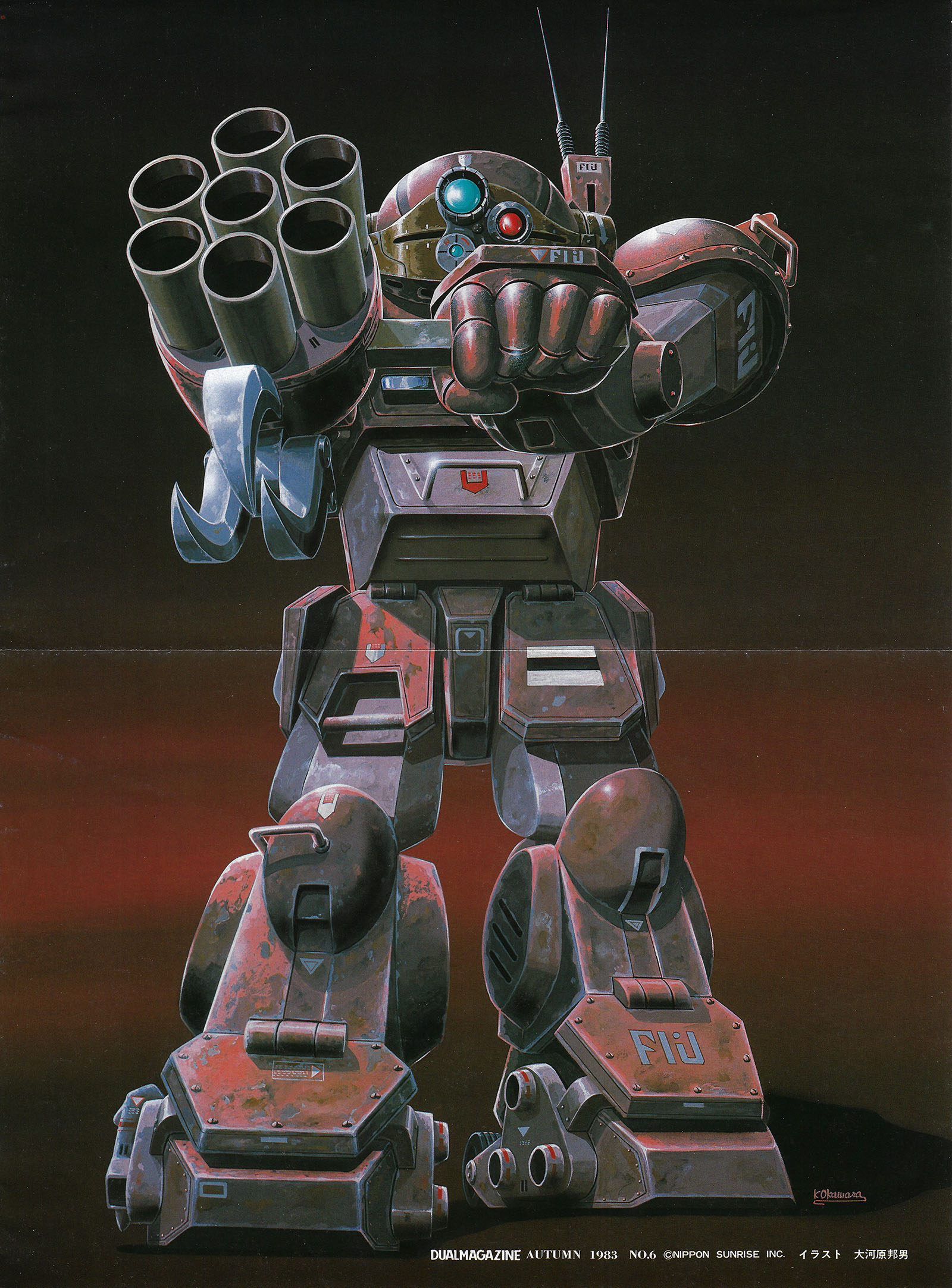
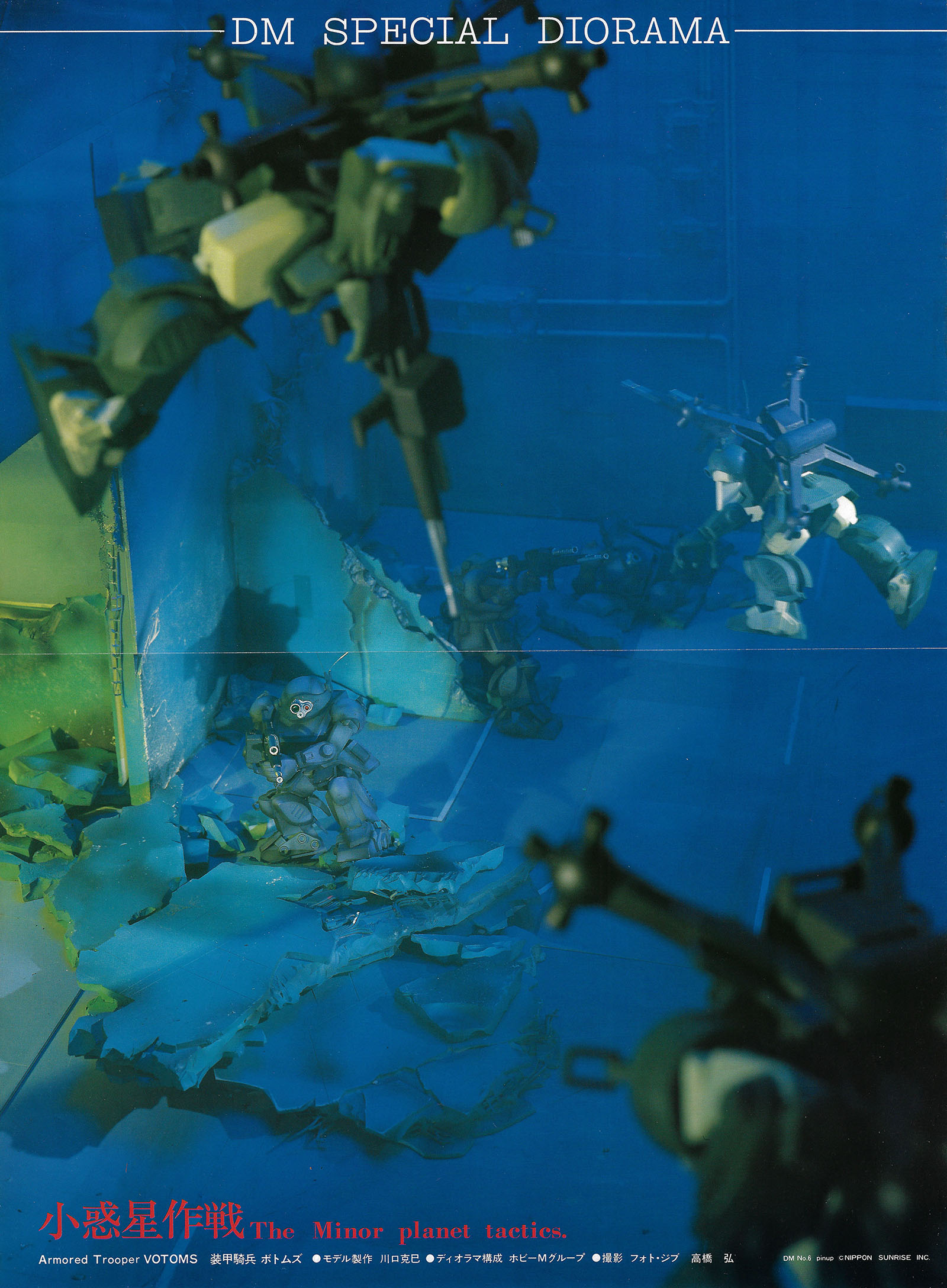
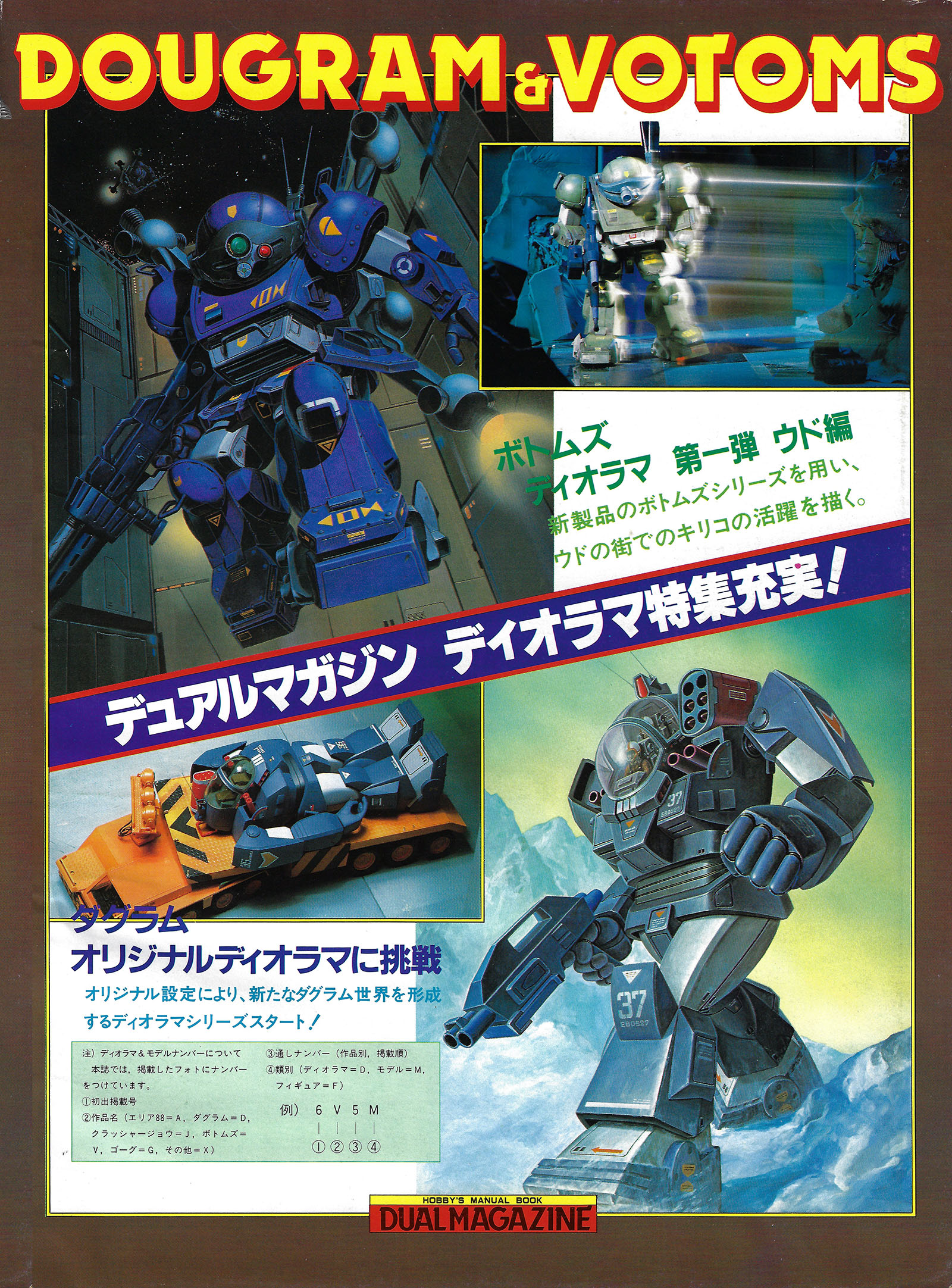
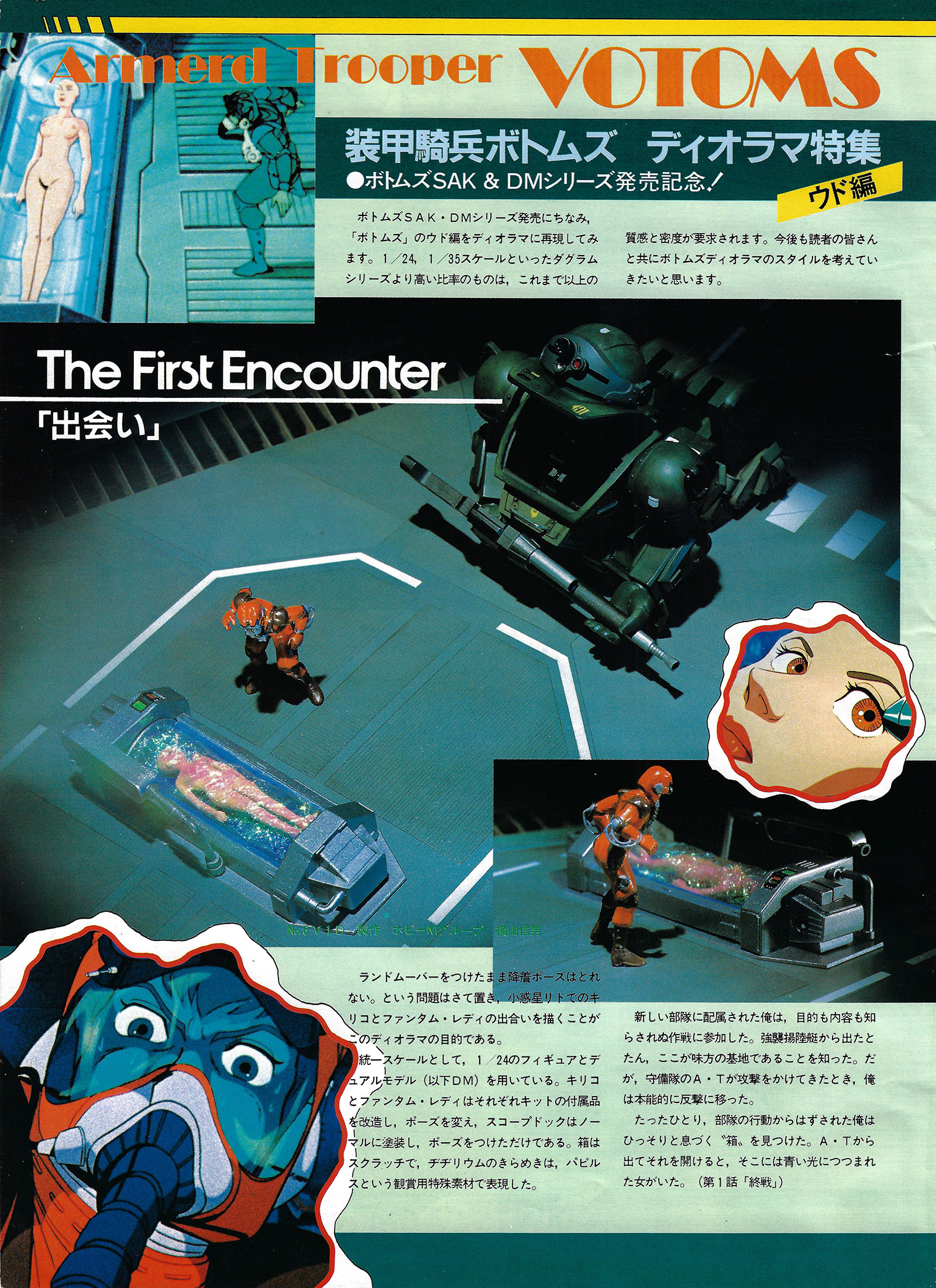
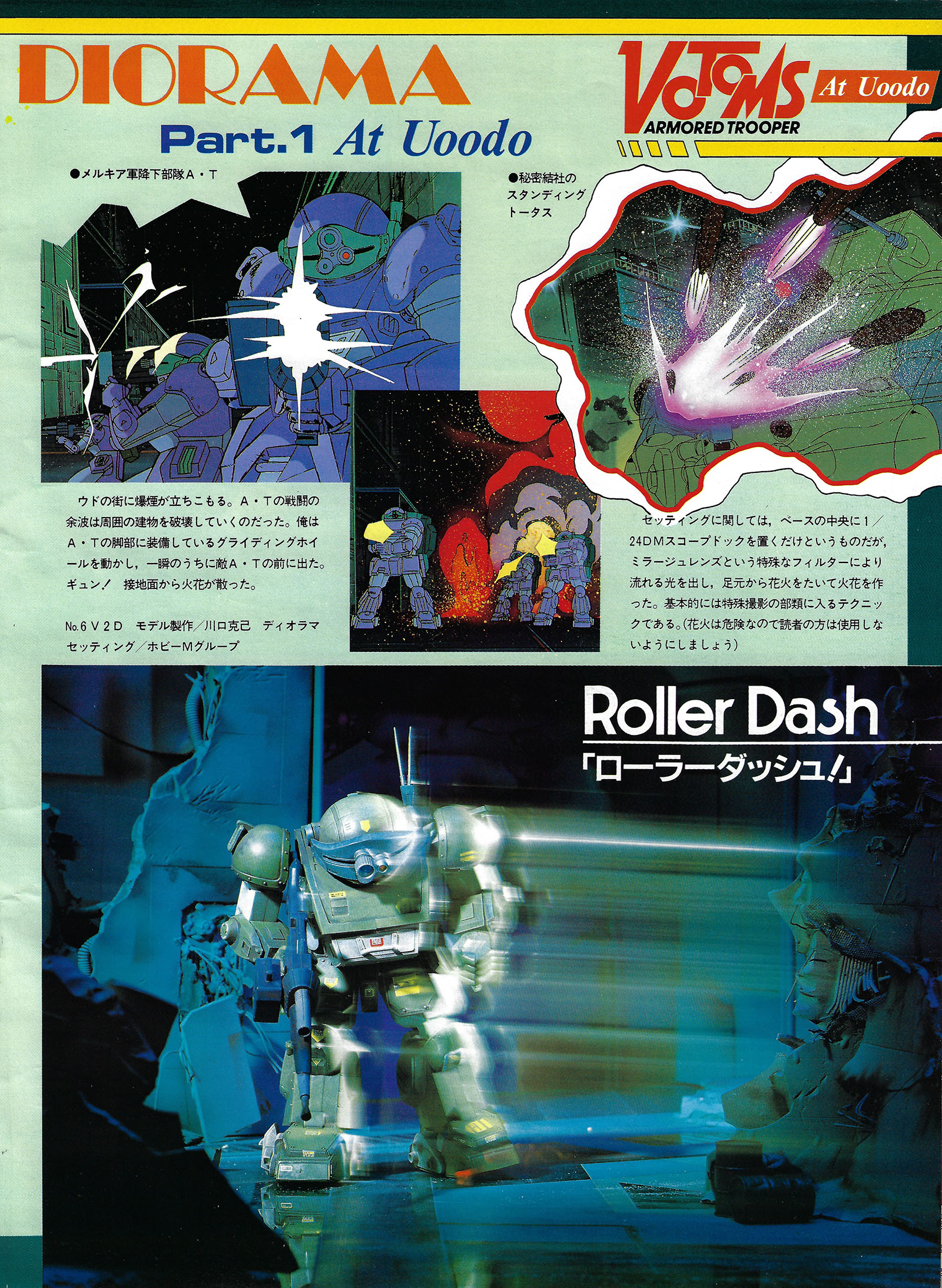
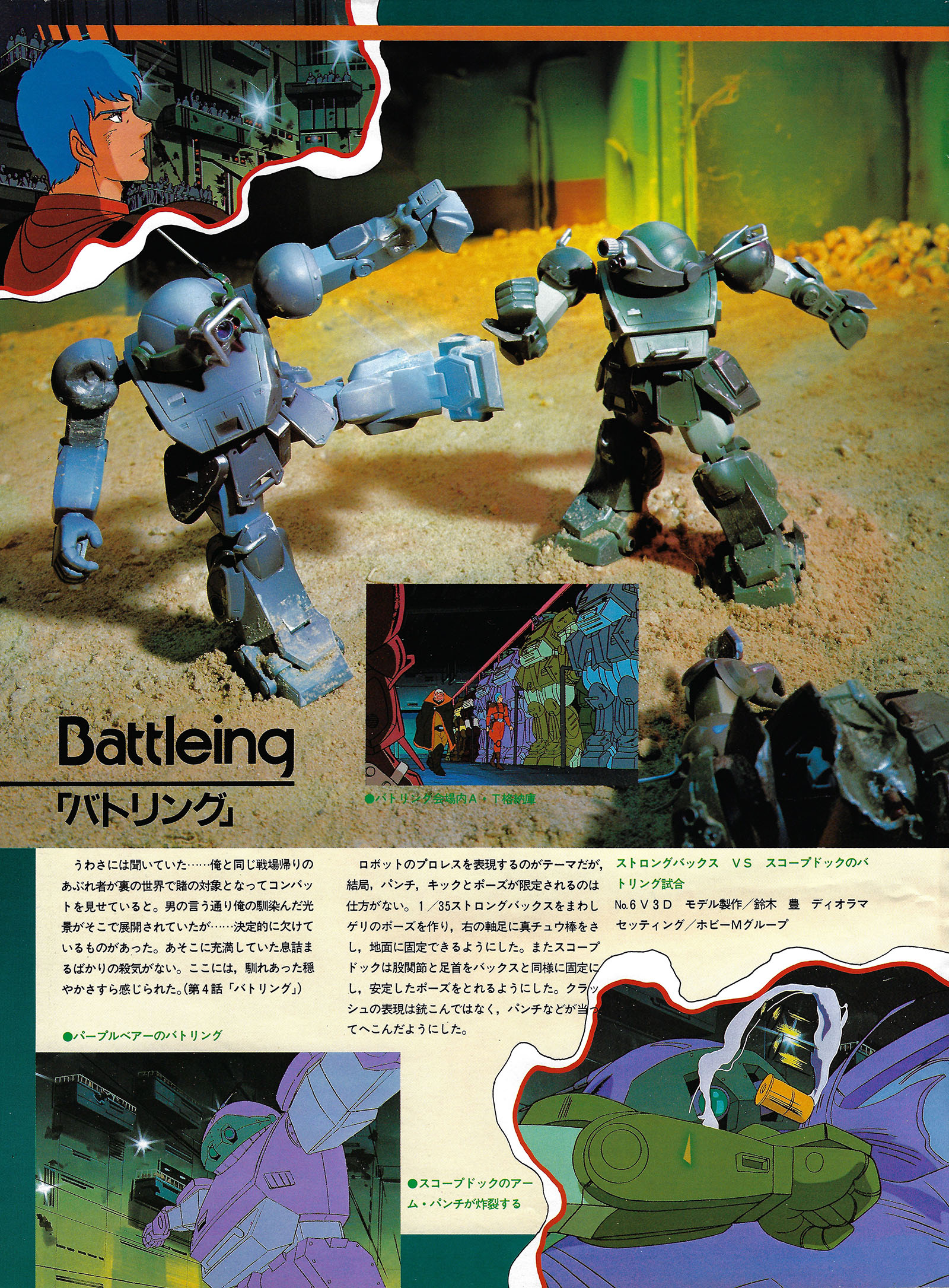
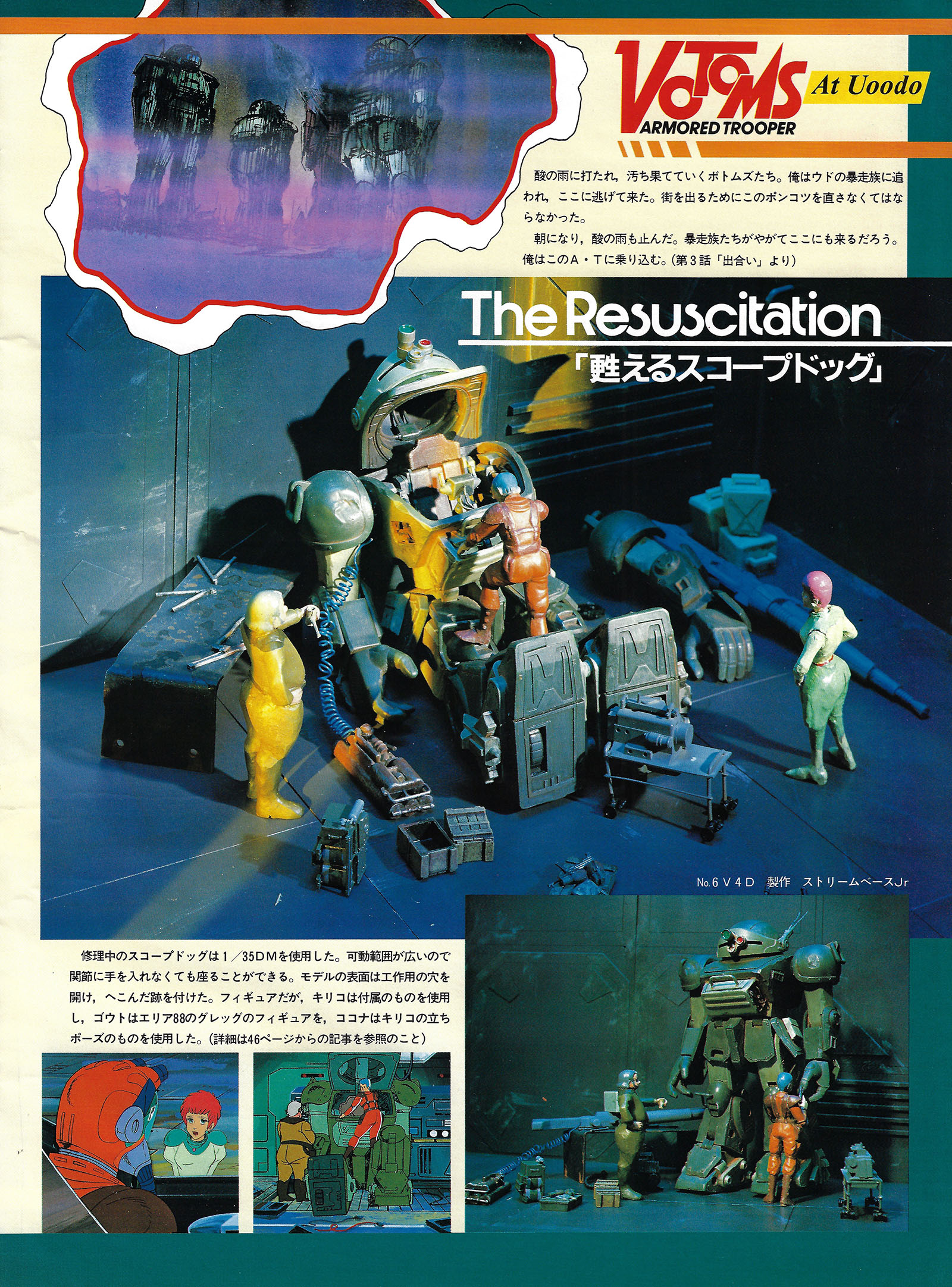
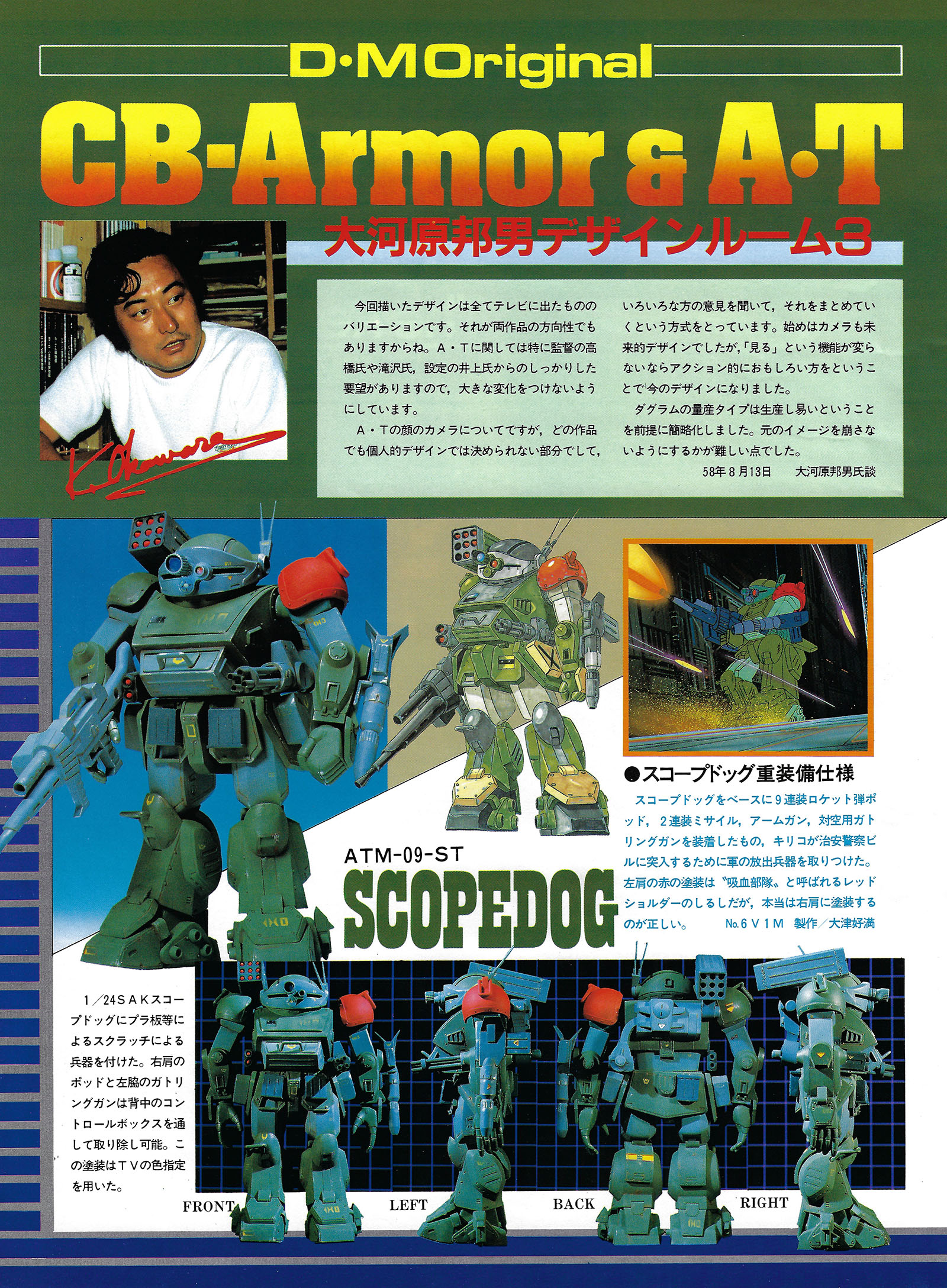
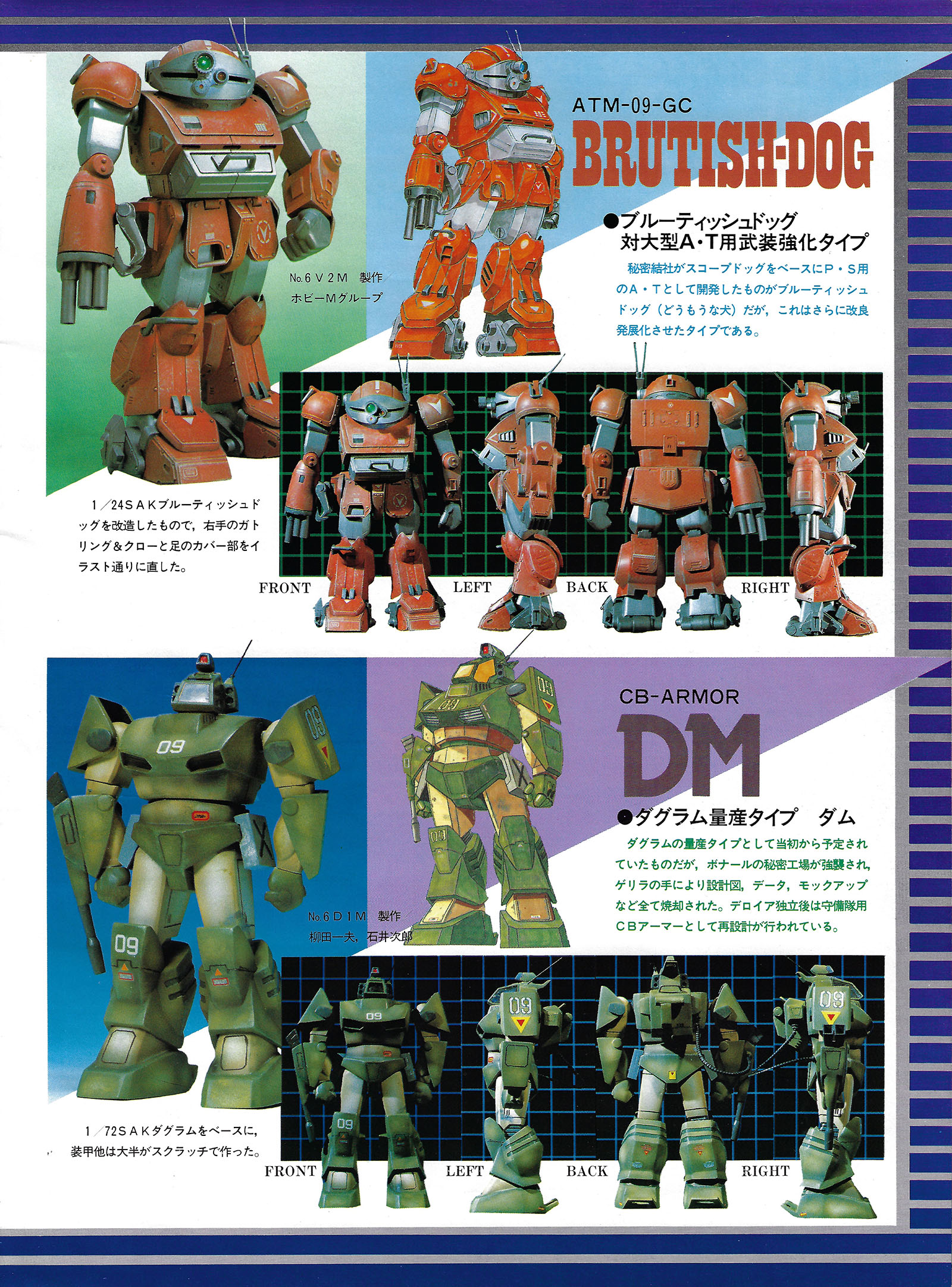
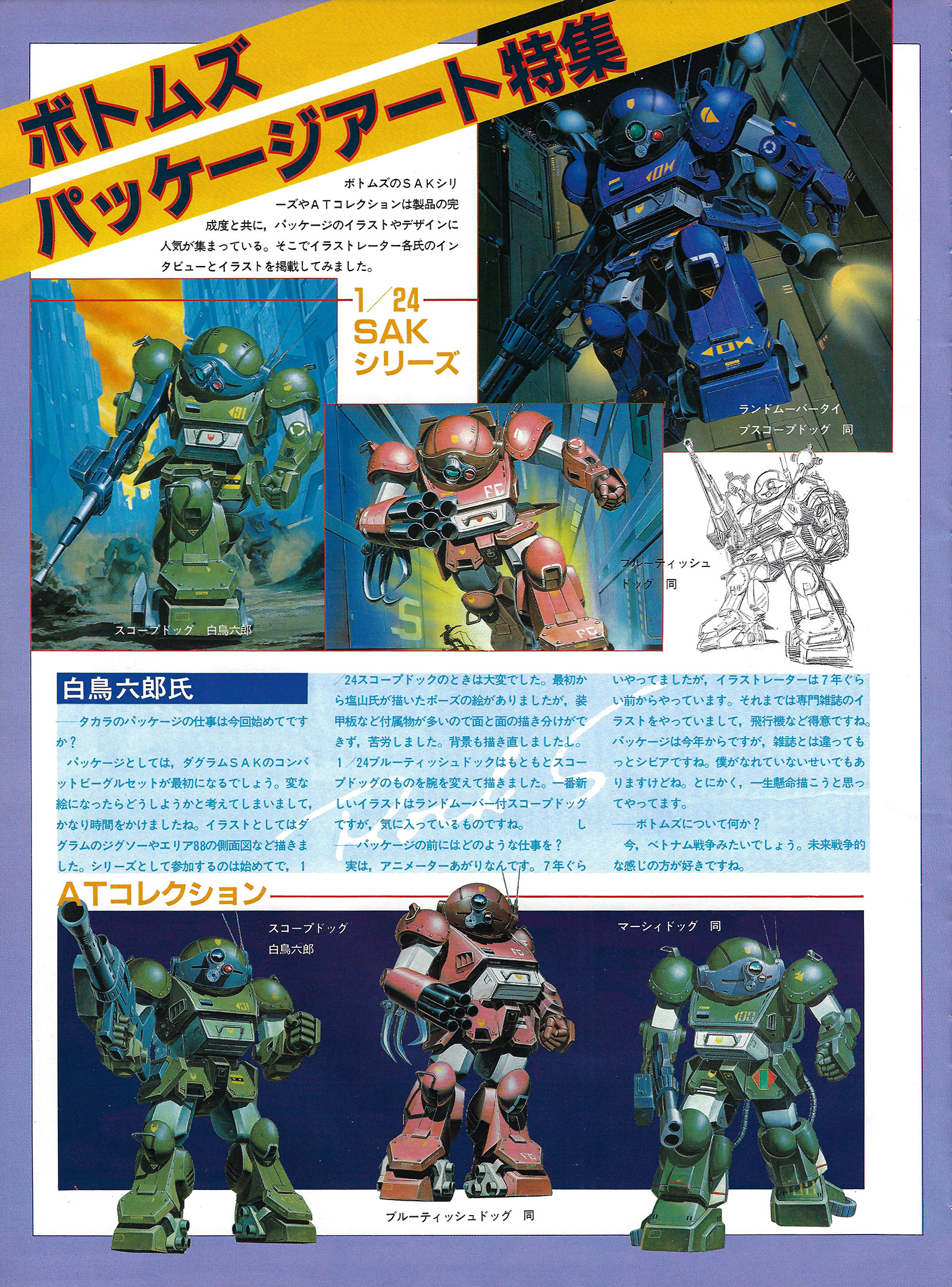
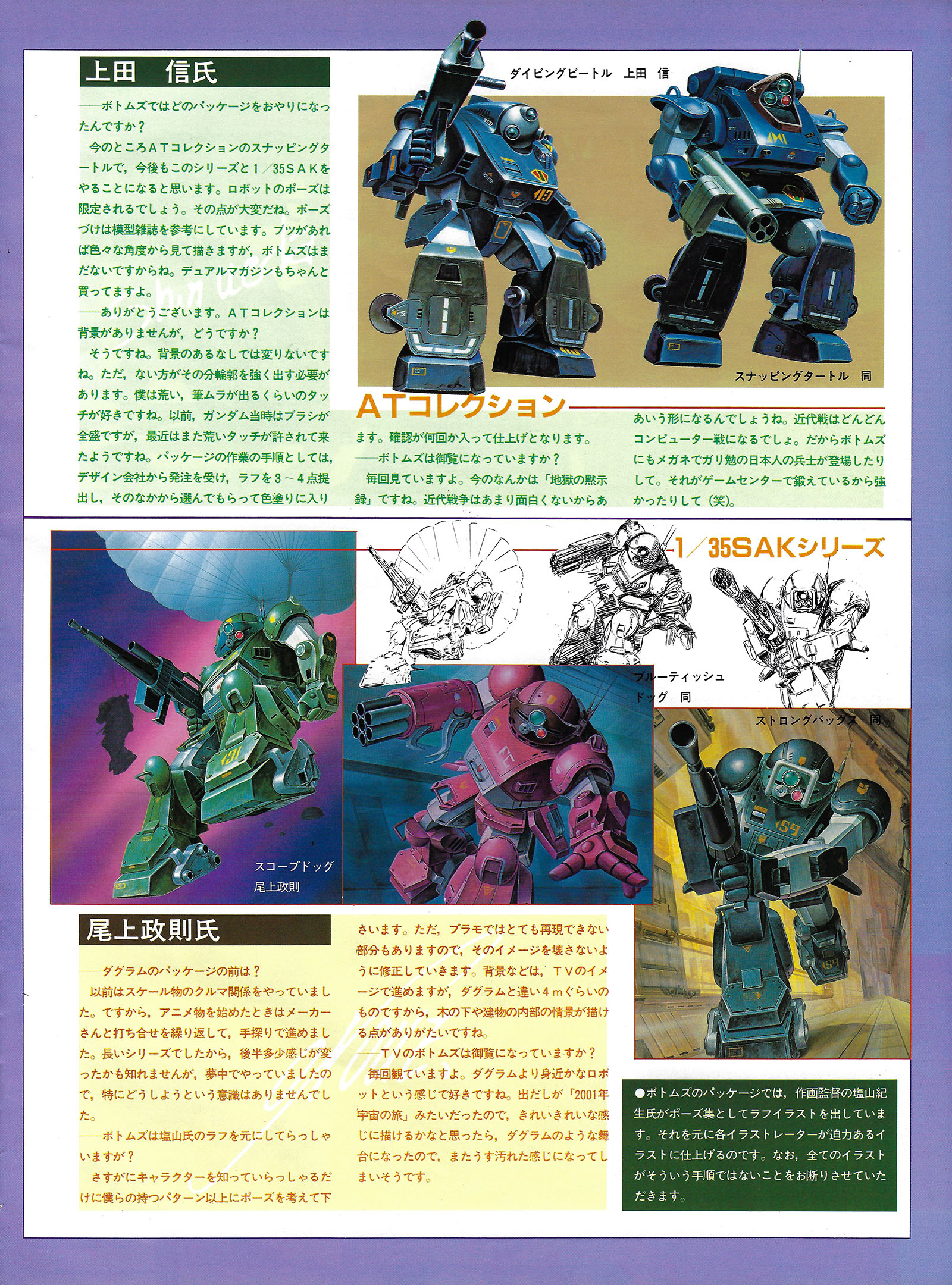
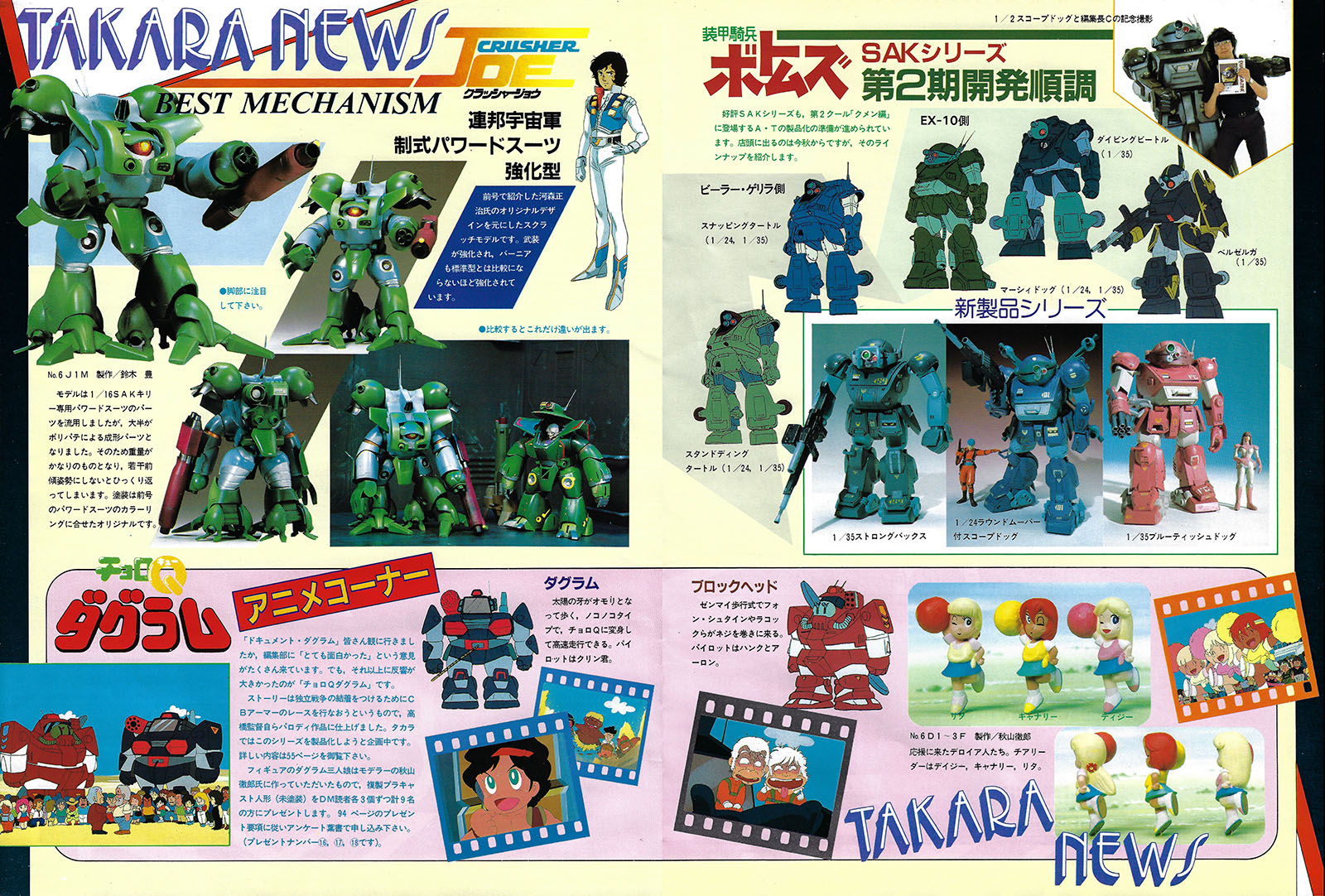
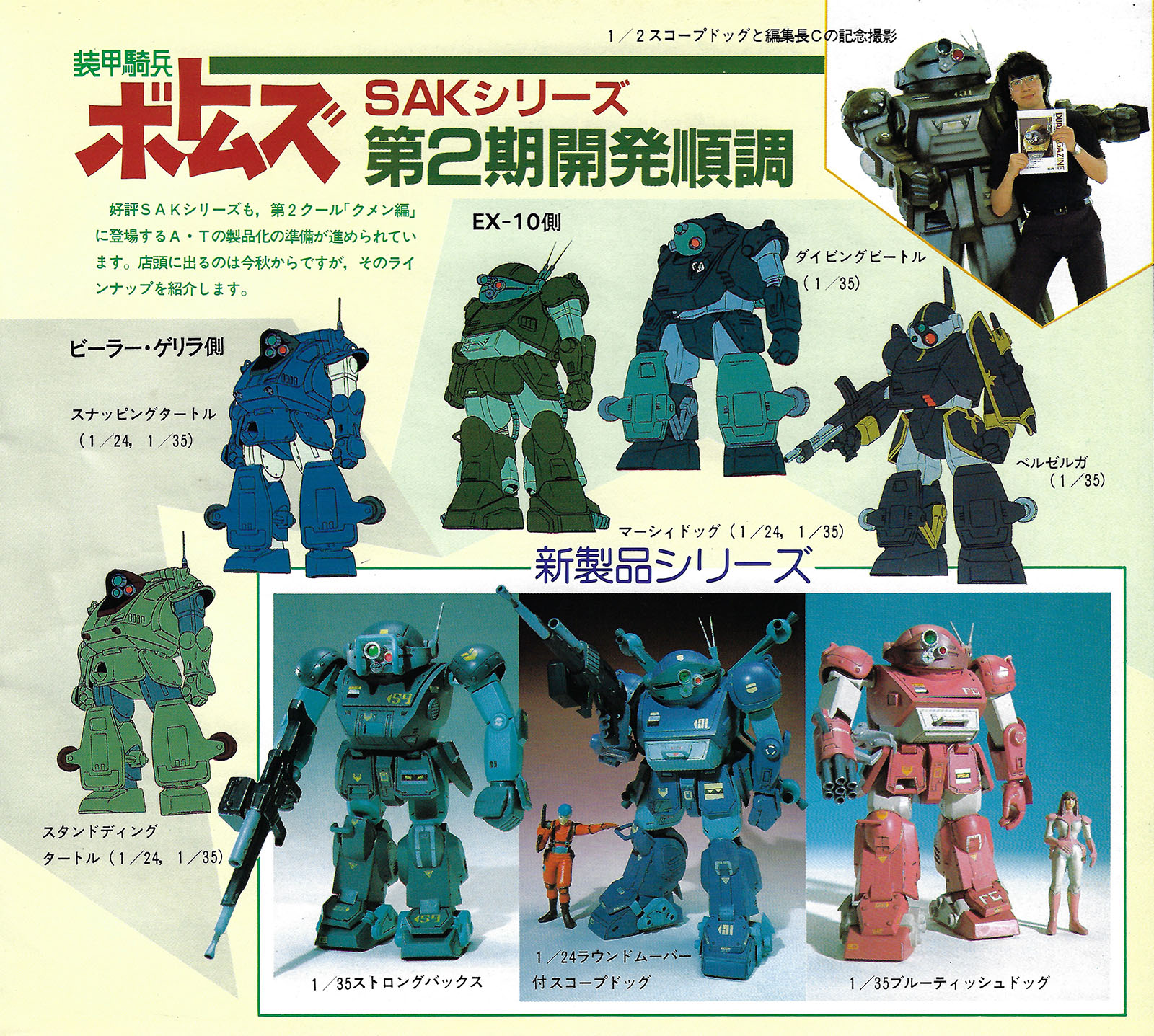
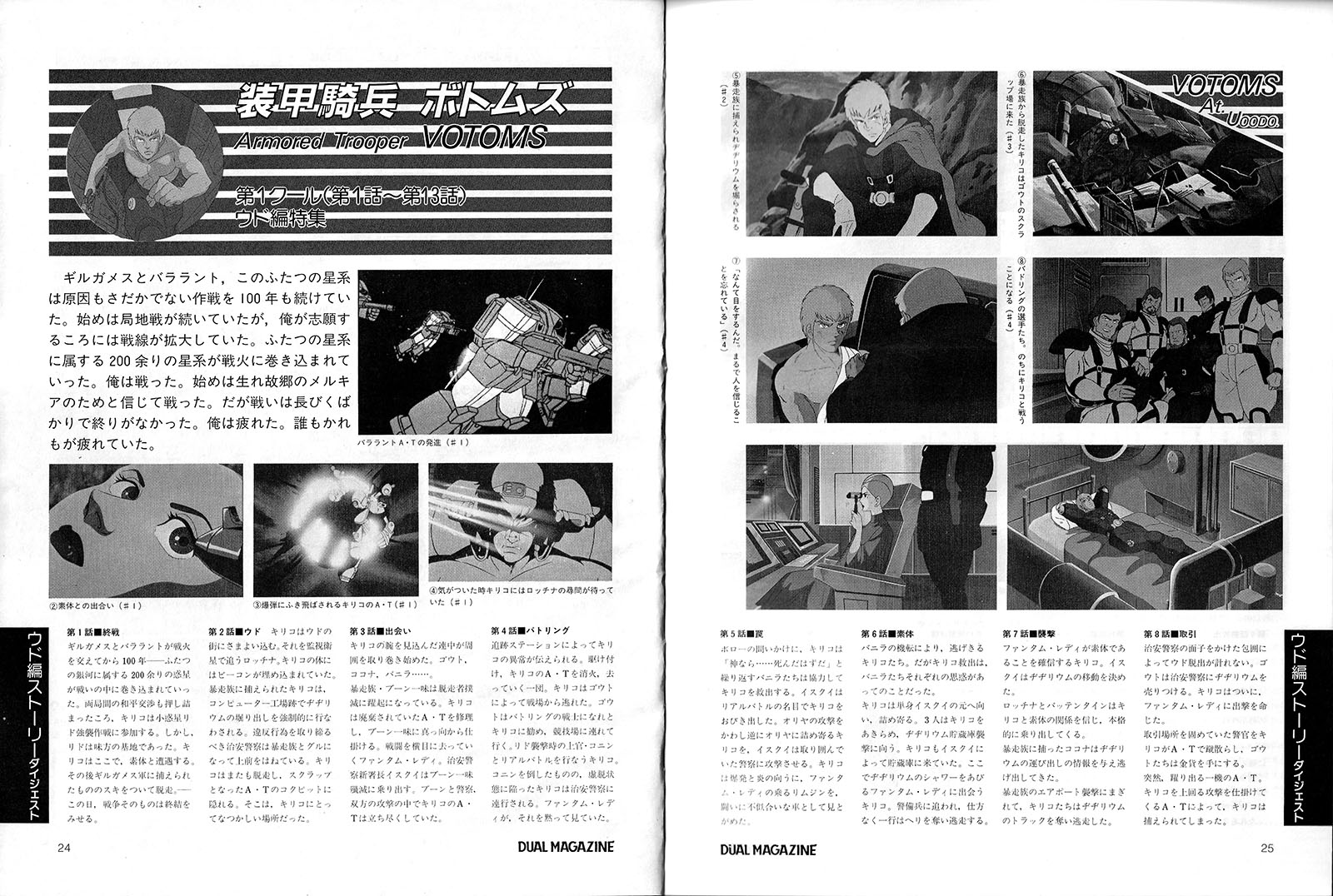
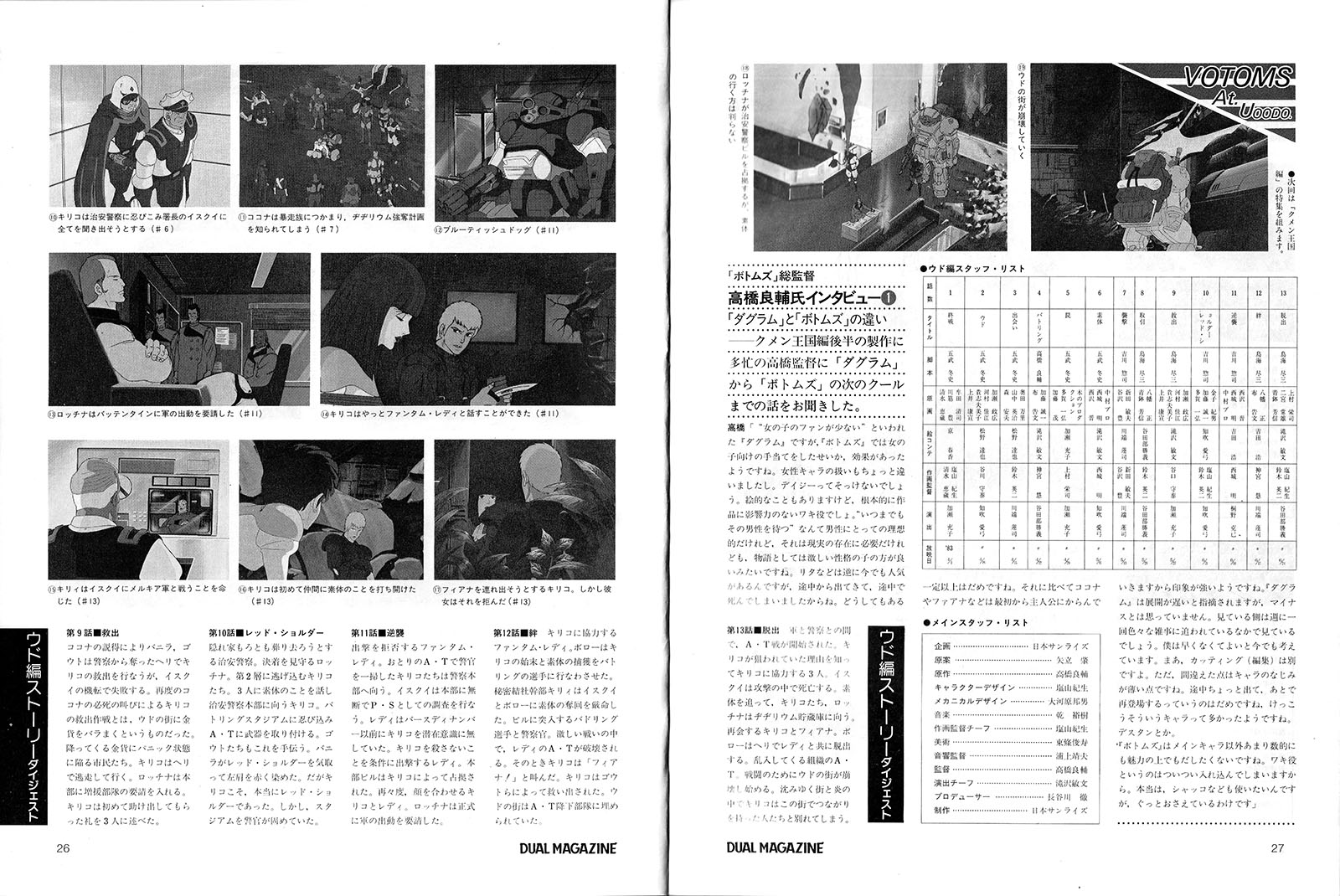
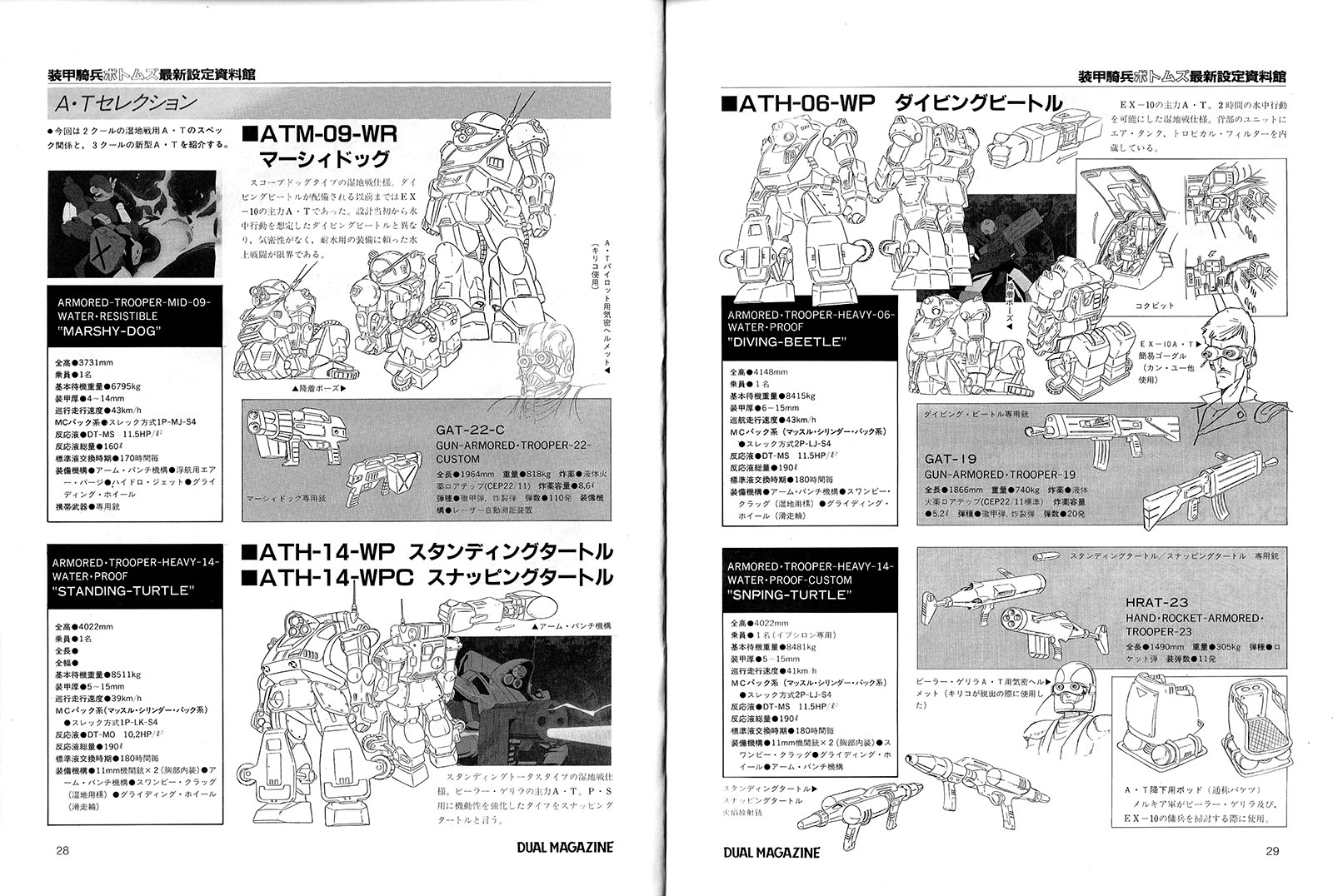
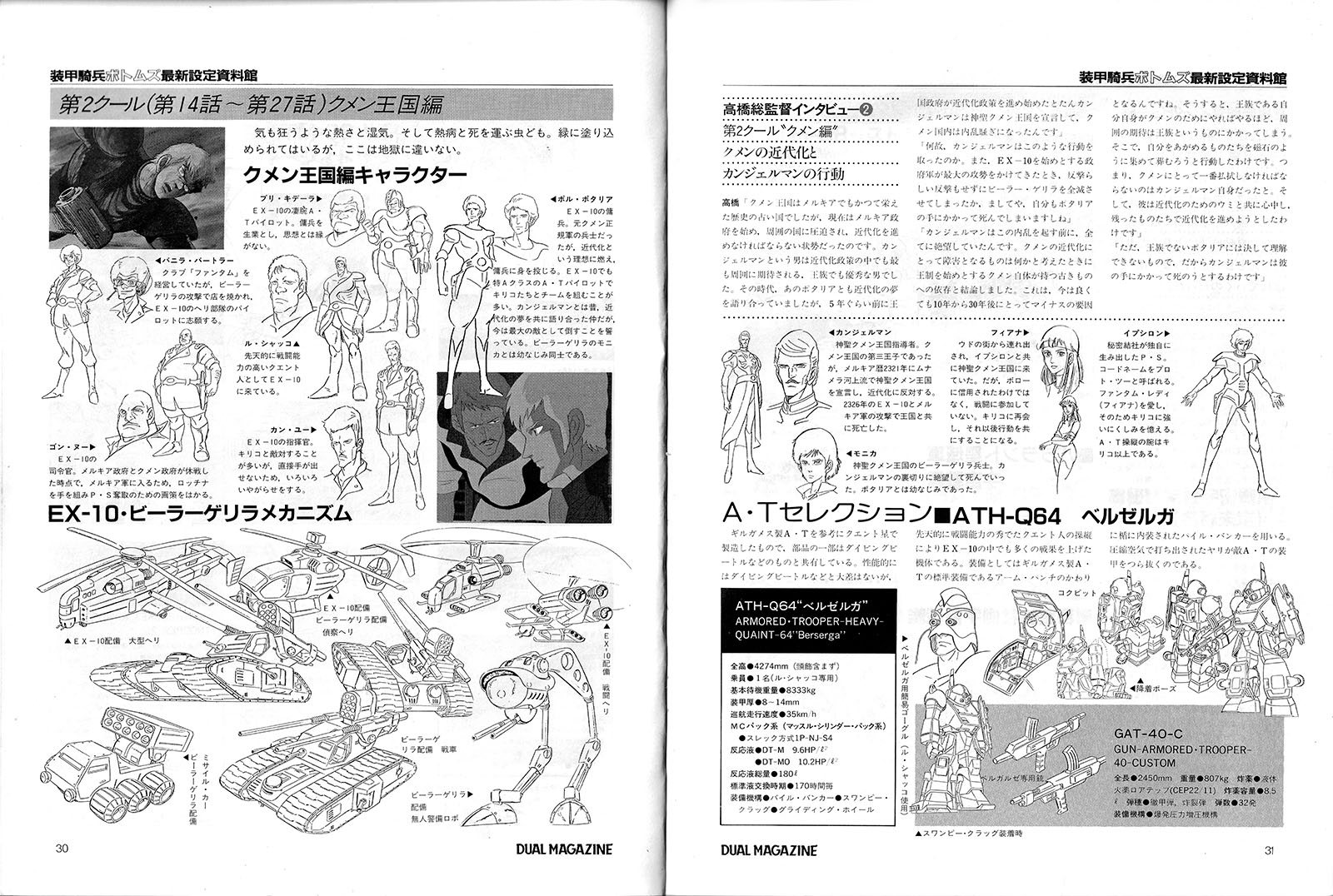
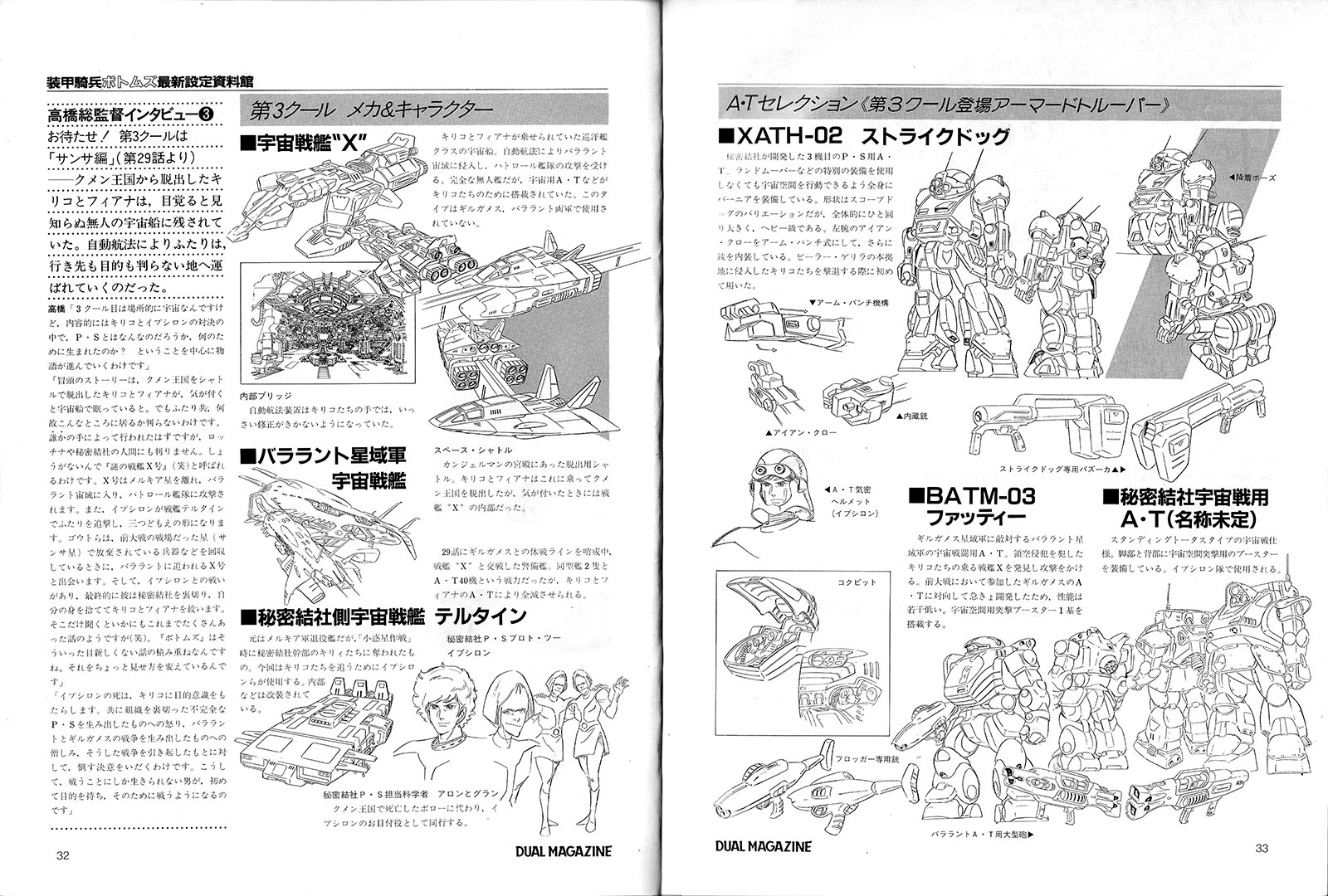
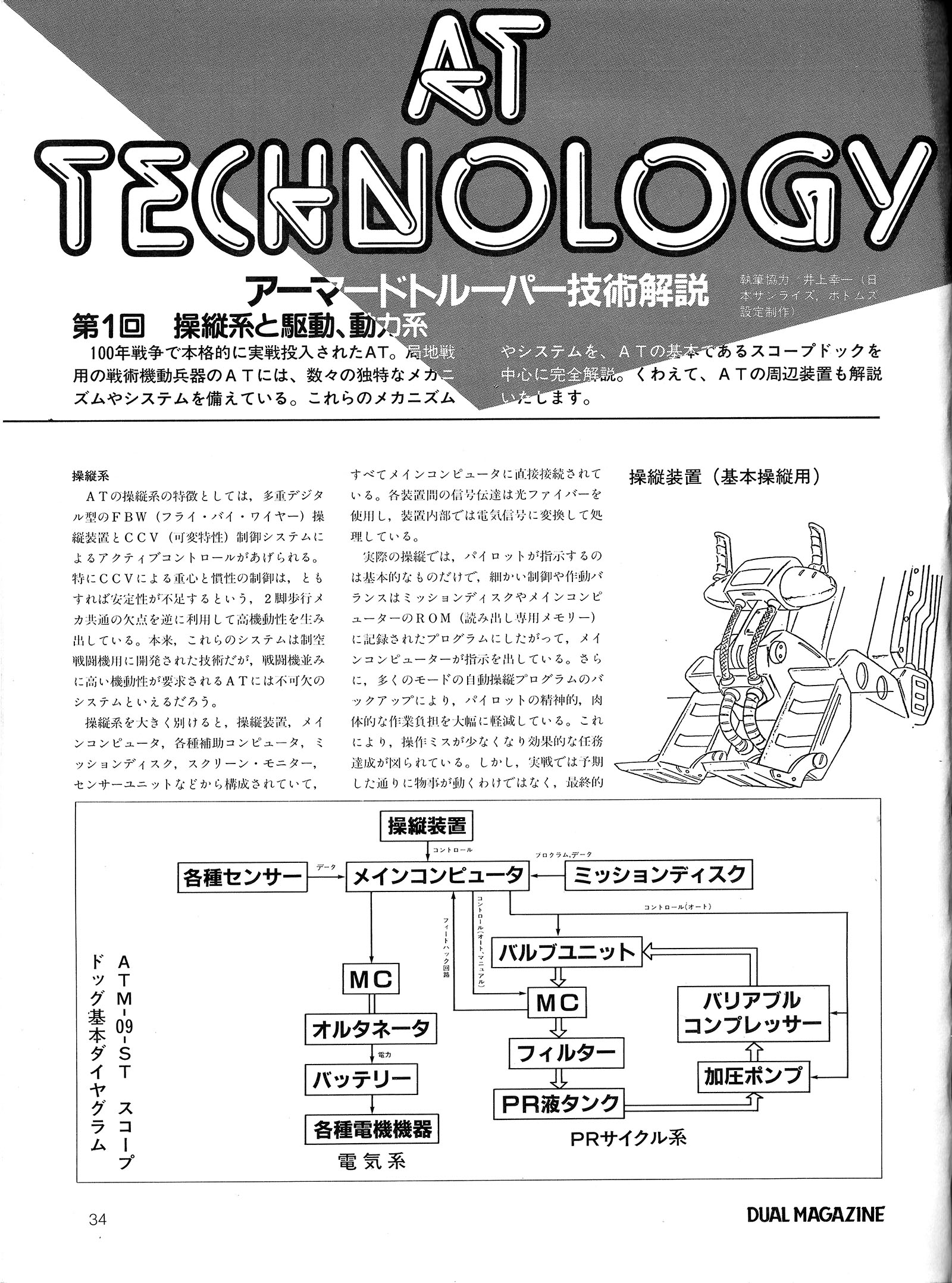
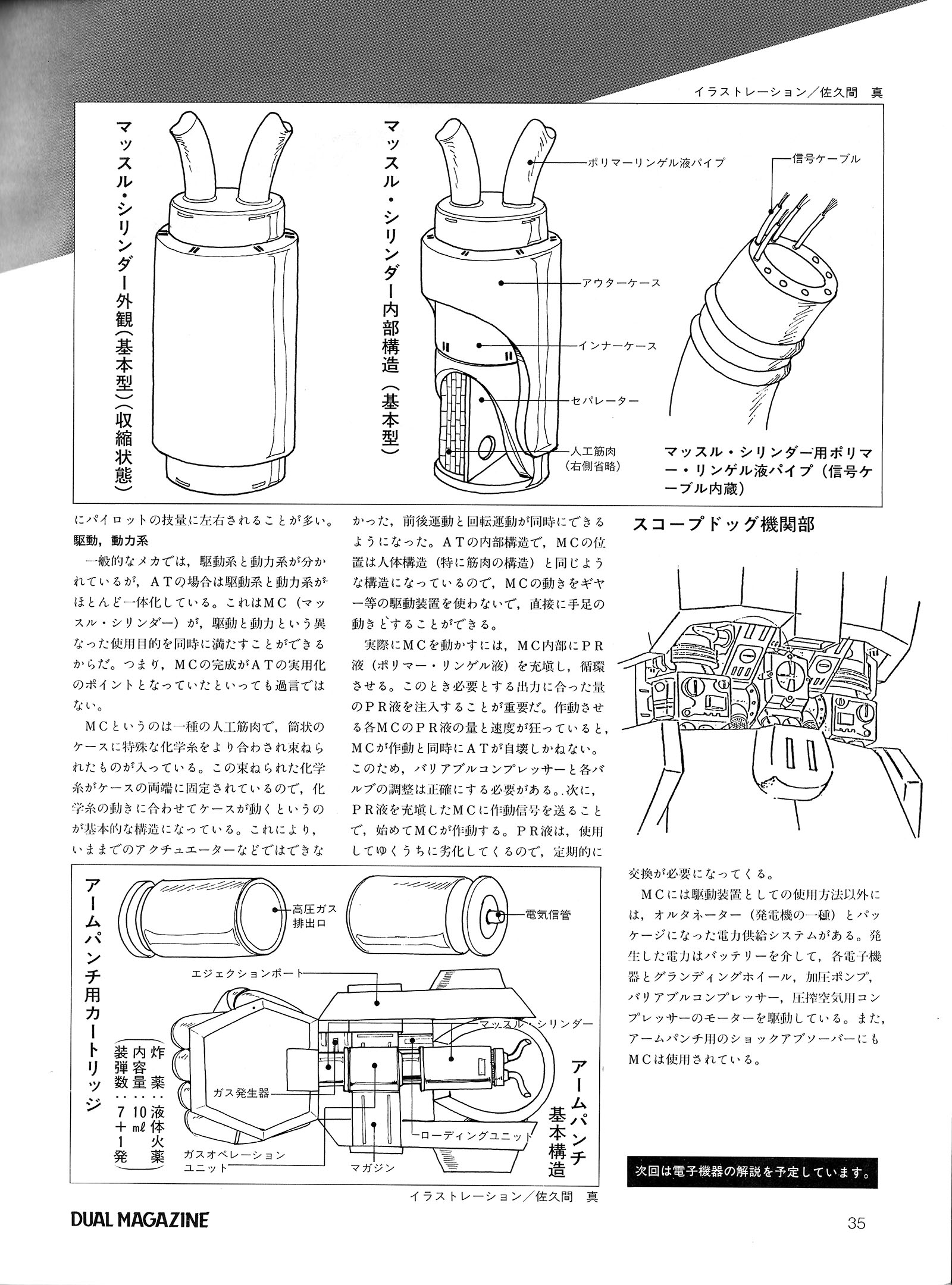
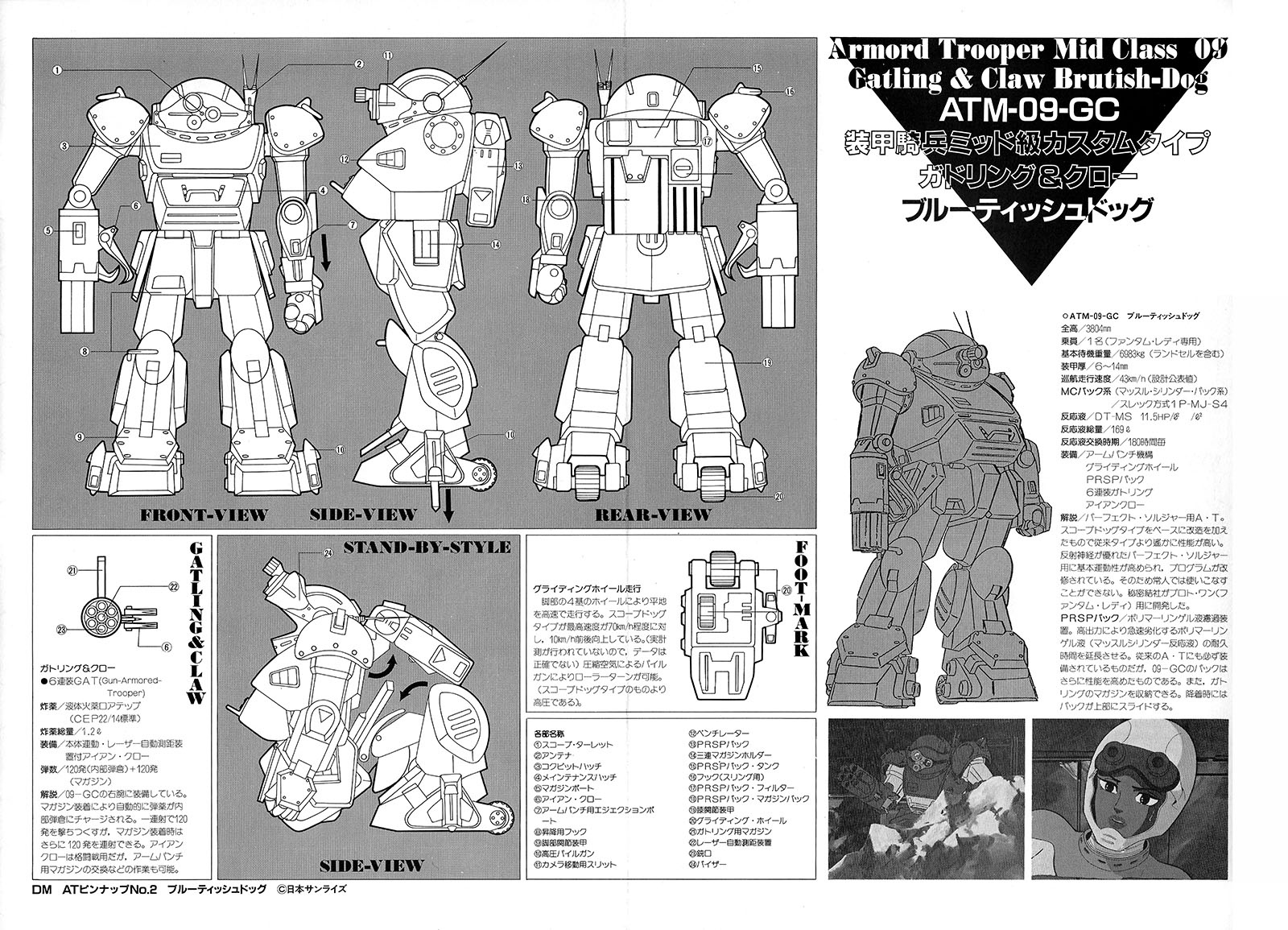
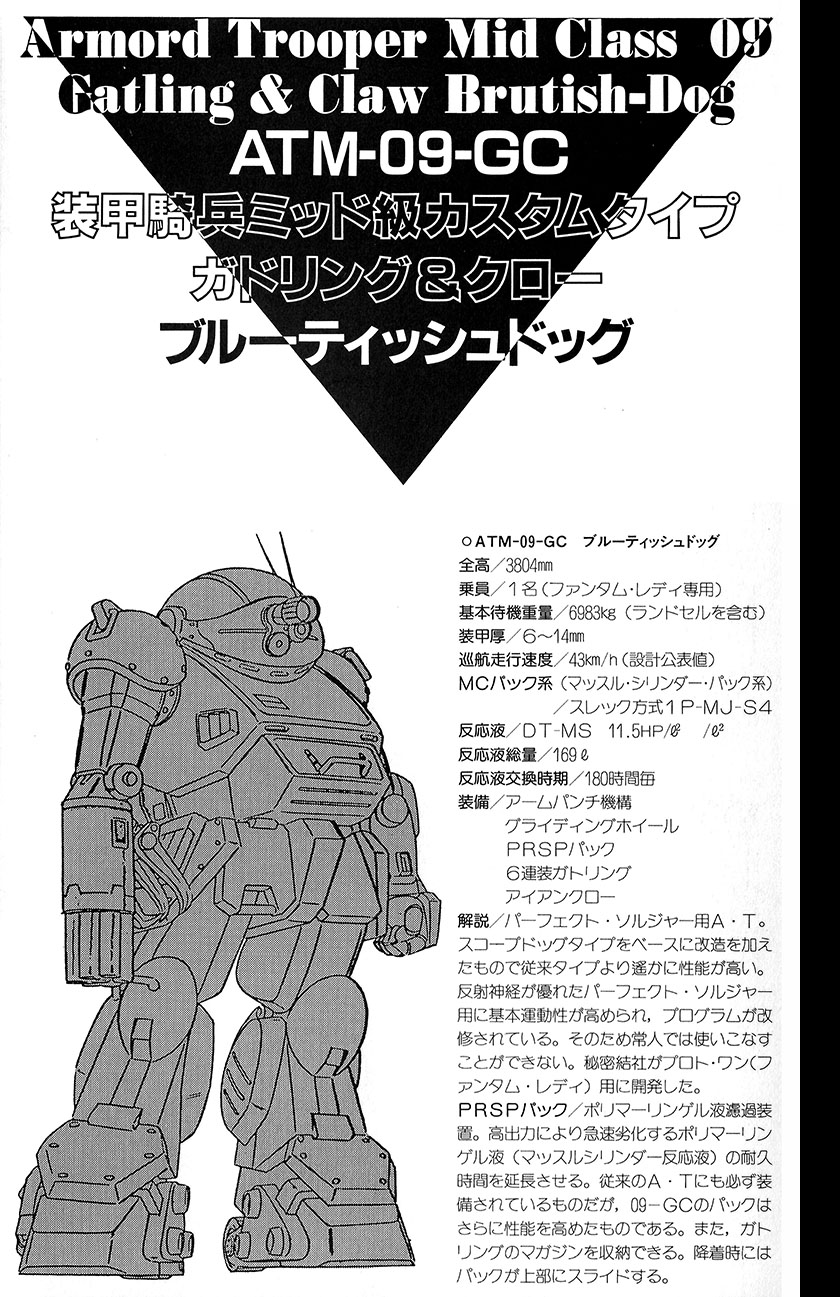
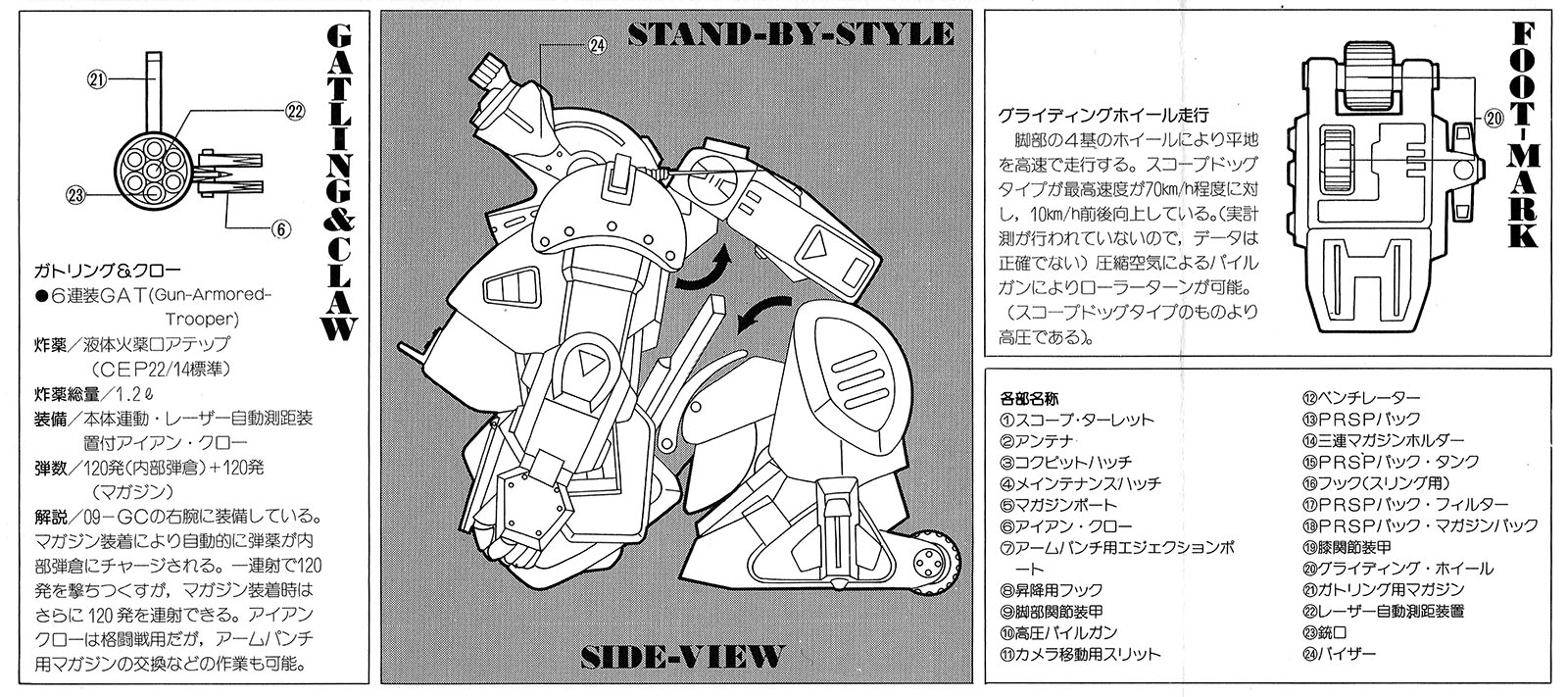
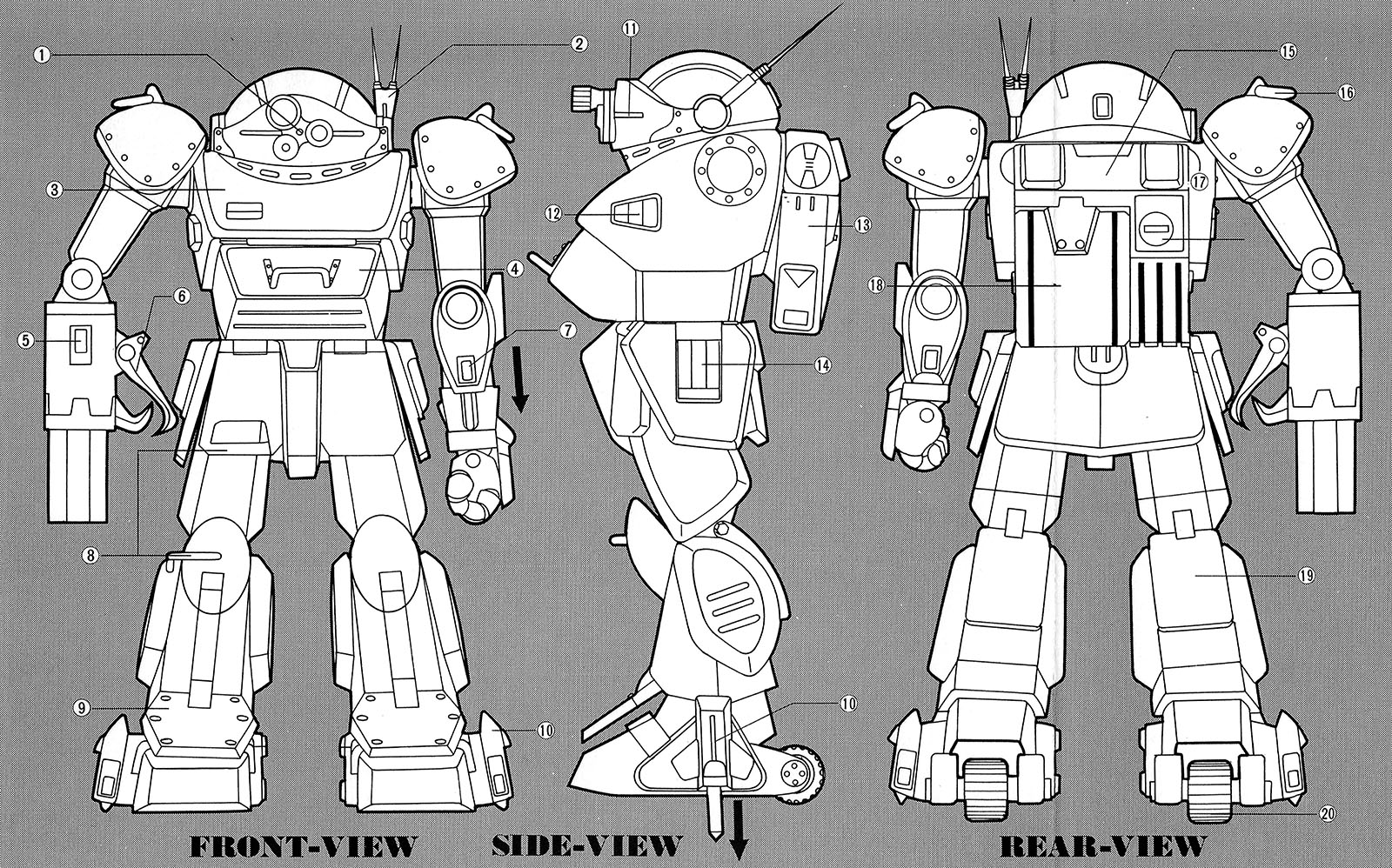
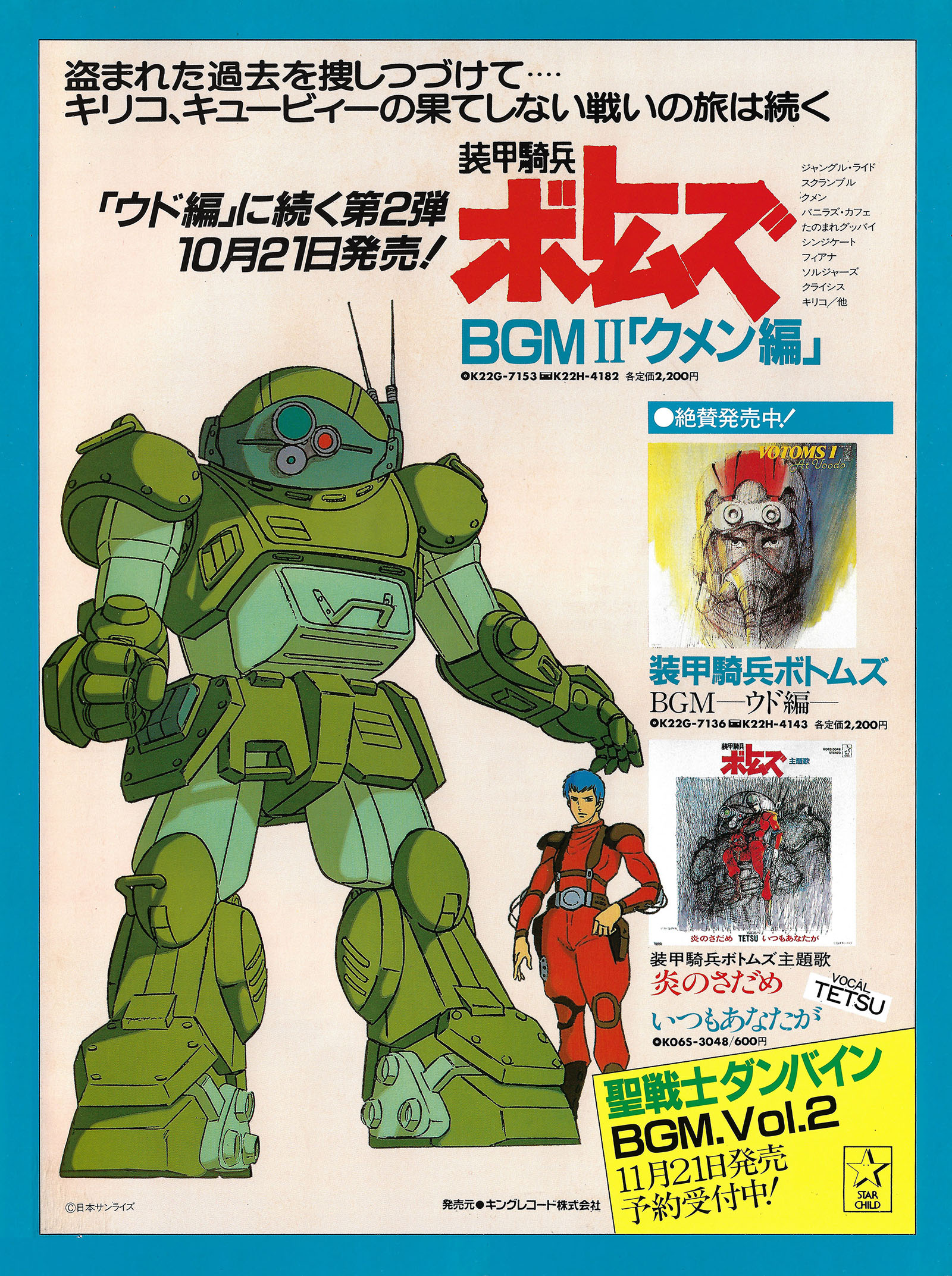
Tim, thank you so much for these translations. For VOTOMS fans, this whole site has been a blessing; keep up the great work!